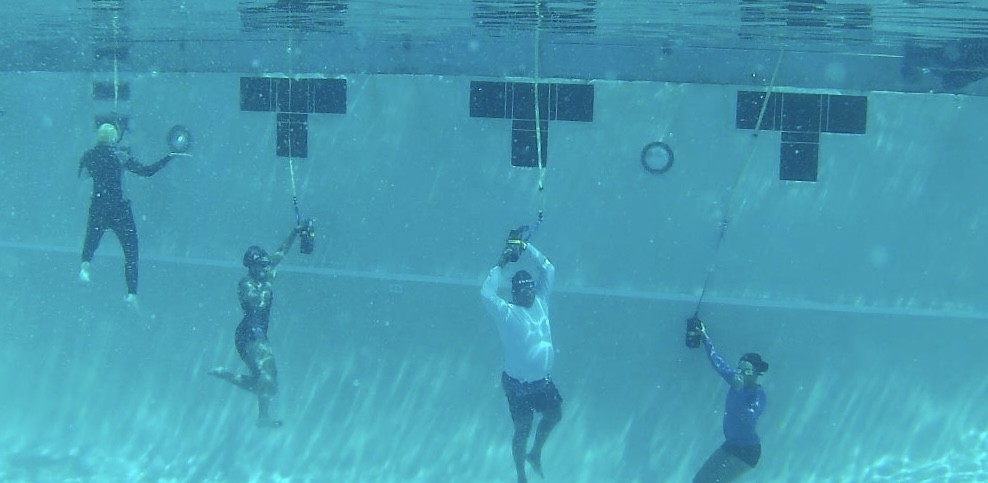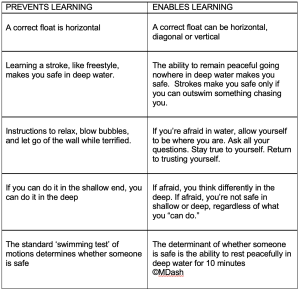State of Emergency in Adult Swimming Lessons
Miracle Swimming School for Adults calls attention to a state of emergency in adult swimming lessons: most do not teach adults to swim (be safe). In the U.S. and around the world, the drowning rates for adults can plummet if new knowledge is incorporated into conventional lessons. Adult beginners are afraid and cannot learn until fear is gone. Eighty percent of U.S. drownings are by adults.

Sarasota, FL, August 10, 2024 --(PR.com)-- A tiny swim school for adults that has taught only the fearful for over 40 years has declared a state of emergency in adult lessons in the U.S. and around the world. After teaching 6,000 afraid adults who traveled from 50 states and 18 countries, Miracle Swimming calls for an end of a century of conventional swimming lessons that cannot teach afraid adults to swim: lessons that teach swimming skills on top of fear rather than healing fear first.
Today:
· Over 50% of adults in the U.S. (more than 120 million) are afraid in water and
cannot swim.
· Eighty percent of drownings in the U.S. are by adults.
· Drowning increased by 19% in adults ages 65–74 in 2022 compared to 2019.
—CDC
The American Red Cross reports that “85% of adults say they can swim, but half of those can’t execute basic water skills.”
“The large instructional agencies don’t realize it,” explains Miracle Swimming founder Melon (M. Ellen) Dash in Sarasota, Florida, “but conventional adult swimming lessons don’t teach basic water skills. They overlook fear. Most adult beginners—those who are afraid in water—cannot learn to be safe there. The high drowning rate is no surprise.”
Afraid students and their instructors have opposing definitions of learning to swim.
Respectively:
1. I can rest and play comfortably in deep water for as long as I’d like, even if I don’t know formal strokes.
2. I can do a stroke from here to there in shallow water.
The first is a portrayal of water safety. Students expect to become calm and safe in deep water. Strokes can be learned later.
The second is a definition commonly found in conventional lessons. It implies, “I can swim because I can move my arms and legs 'like this.’” Strokes fail to make students safe and confident in deep water. Panic is likely the cause of most adult drownings.
Diana Nyad, the swimmer of the 111 miles from Cuba to Florida whose story is told in the movie, NYAD (Netflix), has done television spots on Miracle Swimming. She asserts: “It is flat-out alarming how many adults in our country die from drowning every year. Eighty percent of drownings are by adults. These senseless deaths can be prevented. Most adult swimming programs are not thorough enough to teach someone to save her/his own life. This is the 100%-effective set of skills every adult needs. Let’s do something about adult drownings.”
A new body of knowledge emerged from over 40 years of exclusively teaching afraid adults by Dash and her staff. The advances have rendered conventional methods of adult beginning swimming instruction obsolete. The agencies are unaware of the evolution.
Examples of the new knowledge are:
Prevents Learning:
- A correct float is horizontal.
- Learning a stroke, like freestyle, makes you safe in deep water.
- Instructions to relax, blow bubbles, let go of the wall when terrified.
- If you can do it in the shallow end, you can do it in the deep.
- The standard "swimming test" of motions determines whether someone is safe.
Enables Learning:
- A correct float can be horizontal, diagonal or vertical
- The ability to remain peaceful going nowhere in deep water makes you safe.
Strokes make you safe only if you can out-swim something chasing you.
- If you’re afraid in water, allow yourself to be where you are. Ask all your
questions. Stay true to yourself. Return to trusting yourself.
- If afraid, you think differently in the deep. If afraid, you’re not safe in shallow or
deep, regardless of what you “can do.”
- The determinant of whether someone is safe is the ability to rest peacefully in
deep water for 10 minutes.
Andrea Andrews, aquatic specialist in the U.K and a Director of The Lifesaving Foundation, CLG in Ireland, confirms, “Research shows that adults give up on learning to swim in lessons where they don’t feel safe.”
Dr. Shayne Baker, drowning prevention and water safety expert from the University of Southern Queensland, Toowoomba, Australia, reports, “There is a deficiency in the data available for learn-to-swim and water safety programs for adults. Urgent attention is necessary to neutralize the state of emergency.”
This emergency requires action by students, instructors, and instructional agencies. The best hope for world water safety is to revise curricula of conventional lessons, rewrite training manuals, and train instructors in a proven system that makes afraid adults safe.
To demonstrate a literally infallible teaching system, "Get Comfortable in Water Day" will be held for afraid adults, their instructors, agencies and the press.
Saturday, October 5, 2024, 1-4 pm
Arlington Park Aquatic Center
2650 Waldemere Street
Sarasota, FL 34239
$19
Today:
· Over 50% of adults in the U.S. (more than 120 million) are afraid in water and
cannot swim.
· Eighty percent of drownings in the U.S. are by adults.
· Drowning increased by 19% in adults ages 65–74 in 2022 compared to 2019.
—CDC
The American Red Cross reports that “85% of adults say they can swim, but half of those can’t execute basic water skills.”
“The large instructional agencies don’t realize it,” explains Miracle Swimming founder Melon (M. Ellen) Dash in Sarasota, Florida, “but conventional adult swimming lessons don’t teach basic water skills. They overlook fear. Most adult beginners—those who are afraid in water—cannot learn to be safe there. The high drowning rate is no surprise.”
Afraid students and their instructors have opposing definitions of learning to swim.
Respectively:
1. I can rest and play comfortably in deep water for as long as I’d like, even if I don’t know formal strokes.
2. I can do a stroke from here to there in shallow water.
The first is a portrayal of water safety. Students expect to become calm and safe in deep water. Strokes can be learned later.
The second is a definition commonly found in conventional lessons. It implies, “I can swim because I can move my arms and legs 'like this.’” Strokes fail to make students safe and confident in deep water. Panic is likely the cause of most adult drownings.
Diana Nyad, the swimmer of the 111 miles from Cuba to Florida whose story is told in the movie, NYAD (Netflix), has done television spots on Miracle Swimming. She asserts: “It is flat-out alarming how many adults in our country die from drowning every year. Eighty percent of drownings are by adults. These senseless deaths can be prevented. Most adult swimming programs are not thorough enough to teach someone to save her/his own life. This is the 100%-effective set of skills every adult needs. Let’s do something about adult drownings.”
A new body of knowledge emerged from over 40 years of exclusively teaching afraid adults by Dash and her staff. The advances have rendered conventional methods of adult beginning swimming instruction obsolete. The agencies are unaware of the evolution.
Examples of the new knowledge are:
Prevents Learning:
- A correct float is horizontal.
- Learning a stroke, like freestyle, makes you safe in deep water.
- Instructions to relax, blow bubbles, let go of the wall when terrified.
- If you can do it in the shallow end, you can do it in the deep.
- The standard "swimming test" of motions determines whether someone is safe.
Enables Learning:
- A correct float can be horizontal, diagonal or vertical
- The ability to remain peaceful going nowhere in deep water makes you safe.
Strokes make you safe only if you can out-swim something chasing you.
- If you’re afraid in water, allow yourself to be where you are. Ask all your
questions. Stay true to yourself. Return to trusting yourself.
- If afraid, you think differently in the deep. If afraid, you’re not safe in shallow or
deep, regardless of what you “can do.”
- The determinant of whether someone is safe is the ability to rest peacefully in
deep water for 10 minutes.
Andrea Andrews, aquatic specialist in the U.K and a Director of The Lifesaving Foundation, CLG in Ireland, confirms, “Research shows that adults give up on learning to swim in lessons where they don’t feel safe.”
Dr. Shayne Baker, drowning prevention and water safety expert from the University of Southern Queensland, Toowoomba, Australia, reports, “There is a deficiency in the data available for learn-to-swim and water safety programs for adults. Urgent attention is necessary to neutralize the state of emergency.”
This emergency requires action by students, instructors, and instructional agencies. The best hope for world water safety is to revise curricula of conventional lessons, rewrite training manuals, and train instructors in a proven system that makes afraid adults safe.
To demonstrate a literally infallible teaching system, "Get Comfortable in Water Day" will be held for afraid adults, their instructors, agencies and the press.
Saturday, October 5, 2024, 1-4 pm
Arlington Park Aquatic Center
2650 Waldemere Street
Sarasota, FL 34239
$19
Contact
Miracle Swimming School for Adults
Joseph Federico
(941) 921-6420
https://www.miracleswimming.com/state-of-emergency-adult-swimming-lessons/
Joseph Federico
(941) 921-6420
https://www.miracleswimming.com/state-of-emergency-adult-swimming-lessons/
Multimedia
Categories

